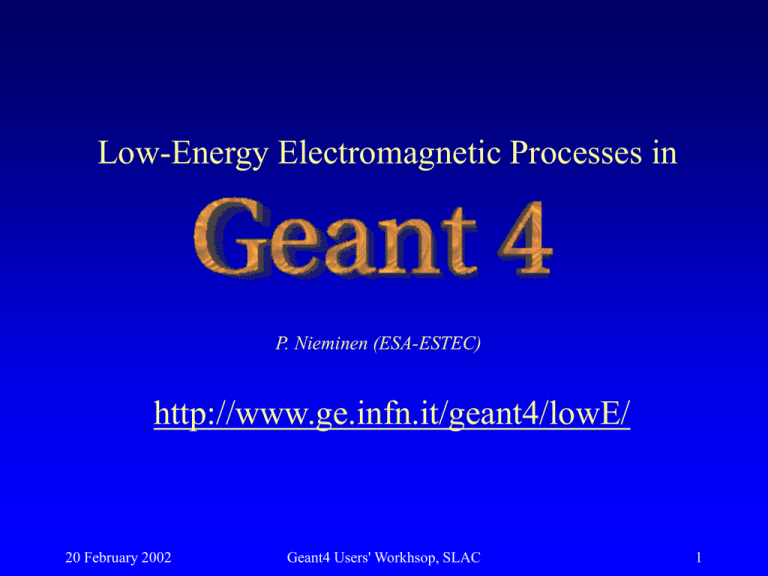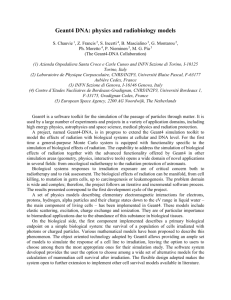G4 lowE em talk
advertisement

Low-Energy Electromagnetic Processes in P. Nieminen (ESA-ESTEC) http://www.ge.infn.it/geant4/lowE/ 20 February 2002 Geant4 Users' Workhsop, SLAC 1 Contents 1. Introduction 2. Electron and photon low-energy electromagnetic processes in Geant4 3. Hadron and ion low-energy electromagnetic processes in Geant4 4. Conclusions 20 February 2002 Geant4 Users' Workhsop, SLAC 2 Dark matter search, Fundamental physics High Energy Physics Radiotherapy, brachytherapy Neutrino physics Radiation effects analysis in X-and g-ray astrophysical observatories Low-Energy e.m. applications Mineralogical surveys of Solar System bodies Spacecraft internal charging analyses Antimatter experiments Electron and photon processes Energy cut-offs Geant3.21 EGS4, ITS3.0 Geant4 “standard models” - Photoelectric effect - Compton effect - Bremsstrahlung - Ionisation (d-rays) - Multiple scattering Geant4 low-energy models 20 February 2002 Geant4 Users' Workhsop, SLAC 10 keV 1 keV 10 keV 10 keV 1 keV 1 keV 1 keV 250 eV 4 Cosmic rays, jovian electrons X-Ray Surveys of Solar System Bodies Solar X-rays, e, p Geant3.21 ITS3.0, EGS4 Courtesy SOHO EIT Induced X-ray line emission: indicator of target composition (~100 mm surface layer) 20 February 2002 Geant4 C, N, O line emissions included Geant4 Users' Workhsop, SLAC 5 Features of electron and photon models Validity range from 250 eV to 100 GeV Elements Z=1 to 100 Data bases: - EADL (Evaluated Atomic Data Library), - EEDL (Evaluated Electrons Data Library), - EPDL97 (Evaluated Photons Data Library) from LLNL, courtesy Dr. Red Cullen. A version of libraries especially formatted for use with Geant4 available from Geant4 distribution source. 20 February 2002 Geant4 Users' Workhsop, SLAC 6 Processes included: …in preparation: Auger effect Positrons Compton scattering Photoelectric effect Rayleigh effect Pair production Bremsstrahlung Ionisation Atomic relaxation Polarised processes 20 February 2002 New physics Geant4 Users' Workhsop, SLAC 7 OOAD Technology as a support to physics Rigorous adoption of OO methods openness to extension and evolution Extensive use of design patterns Booch methodology 20 February 2002 Geant4 Users' Workhsop, SLAC 8 Calculation of total cross sections log 1 log E2 / E log 2 log E / E1 log E log E2 / E1 where E1 and E2 are respectively the lower and higher energy for which data (1 and 2) is available. 1 i E ni i Mean free path for a given process at energy E, with ni the atomic density of the ith element contributing to the material composition 20 February 2002 Geant4 Users' Workhsop, SLAC 9 Compton scattering Energy distribution of the scattered photon according to KleinNishina formula multiplied by scattering functions F(q) from EPDL97 data library. The effect of scattering function becomes significant at low energies (suppresses forward scattering) Angular distribution of the scattered photon and the recoil electron also based on EPDL97. Rayleigh effect Angular distribution: F(E,q)=[1+cos2q]F2(q), where F(q) is the energy-dependent form factor obtained from EPDL97. 20 February 2002 Geant4 Users' Workhsop, SLAC 10 Gamma conversion The secondary e- and e+ energies sampled using Bethe-Heitler cross sections with Coulomb correction e- and e+ assumed to have symmetric angular distribution Energy and polar angle sampled w.r.t. the incoming photon using Tsai differential cross section Azimuthal angle generated isotropically Choice of which particle in the pair is e- or e+ is made randomly Photoelectric effect Subshell from which the electron is emitted selected according to the cross sections of the sub-shells. De-excitation via isotropic fluorescence photons; transition probabilities from EADL. 20 February 2002 Geant4 Users' Workhsop, SLAC 11 Photons 20 February 2002 Geant4 Users' Workhsop, SLAC 12 Electron bremsstrahlung TC d t dt dt dE 0.1 eV s T TMAX dx d s dt dt 0 . 1 eV Continuous energy loss TMAX d dt dt TC T s T TMAX d s dt dt 0.1 eV d F x t , x dt x T F(x) obtained from EEDL. At high energies: F x 1 x 0.75x 2 Direction of the outgoing electron the same as that of the incoming one; angular distribution of emitted photons generated according to a simplified formula based on the Tsai cross section (expected to become isotropic in the low-E limit) Gamma ray production 20 February 2002 Geant4 Users' Workhsop, SLAC 13 Electron ionisation The d-electron production threshold Tc is used to separate the continuous and discrete parts of the process Partial sub-shell cross sections s obtained by interpolation of the evaluated cross section data in the EEDL library Interaction leaves the atom in an excited state; sampling for excitation is done both for continuous and discrete parts of the process Both the energy and the angle of emission of the scattered electron and the d-ray are considered The resulting atomic relaxation treated as follow-on separate process 20 February 2002 Geant4 Users' Workhsop, SLAC 14 Electron ionisation TC d t dt dt dE 0.1 eV s T TMAX dx d s dt dt 0 . 1 eV t Bs d P x C 2 , x dt T Bs x Bs is the binding energy of sub-shell s x2 1 A Px 1 gx 1 g x g 1 x 1 x x 2 Continuous energy loss TMAX d dt dt TC T s T TMAX d s dt dt 0.1 eV g 2g 1 / g 2 Value of coefficient A for each element is obtained from fit to EEDL data for energies available in the database d-electron production 20 February 2002 Geant4 Users' Workhsop, SLAC 15 Atomic relaxation EADL data used to calculate the complete radiative and nonradiative spectrum of X-rays and electrons emitted Auger effect and Coster-Kronig effect under development; fluorescent transitions implemented Transition probabilities explicitly included for Z=6 to 100 K, L, M, N, and some O sub-shells considered. Transition probabilities for sub-shells O, P, and Q negligible (<0.1%) and smaller than the precision with which they are known For Z=1 to 5, a local energy deposit corresponding to the binding energy B of an electron in the ionised sub-shell simulated. For O, P, and Q sub-shells a photon emitted with energy B 20 February 2002 Geant4 Users' Workhsop, SLAC 16 Atomic relaxation Domain decomposition leads to a design open to physics extensions 20 February 2002 Geant4 Users' Workhsop, SLAC 17 20 February 2002 Geant4 Users' Workhsop, SLAC 18 Delta = (NIST-G4EMStand) / NIST Delta = (NIST-G4LowEn) / NIST 16 14 12 water 10 water 8 6 Delta (%) 4 2 0 -2 -4 -6 -8 -10 -12 -14 -16 0.01 m /r (cm 2 /g) in iron 100 10 Photon attenuation coefficient Comparison with NIST data Fe 10 1 Photon Energy (MeV) Geant4 LowEn NIST 1000 0.1 1 0.1 0.01 0.01 0.1 Photon Energy (MeV) 20 February 2002 1 10 Standard electromagnetic package and Low Energy extensions Geant4 Users' Workhsop, SLAC 19 Thorax slice CT image 6 MV photon beam Siemens KD2 Courtesy LIP and IPOFG-CROC (Coimbra delegation of the Portuguese Oncology Institute) 20 February 2002 Geant4 Users' Workhsop, SLAC 20 Polarised Compton Scattering x The Klein-Nishina cross section: d 1 2 h2 h0 h 2 r0 2 2 4 cos d 4 h0 h h0 x h0 Where, h0 : energy of incident photon h : energy of the scattered photon : angle between the two y polarization vectors 20 February 2002 Geant4 Users' Workhsop, SLAC O h q a f A z C 21 Angular distribution of scattered radiation composed of two components: ’|| and ’^ with respect to AOC plane ’|| x ’ b x h O x ’^ A C d 1 2 h2 h0 h 2 2 r0 2 sin q cos f 2 d 2 h0 h h0 20 February 2002 f distribution obtained with the class Geant4 Users' Workhsop, SLAC 22 Test of the distribution: a) Low energy b) High energy The distribution function is: P and m = h / h0. Low energy: ho << mc2 1 a b cos 2 ab => h ho => m =1 where a m => 1 m 2,b 4 a=0 the distribution reduces to the Thompson distribution => the probability that the two polarization vectors are perpendicular is zero. High energy: small q => h ho => equal to low energy high q: it is possible to demonstrate that b/(a+b) ->0, so in this case the distribution tend to be isotropic. 20 February 2002 Geant4 Users' Workhsop, SLAC 23 Results Scalar product between the two polarization vectors for three different energies. Upper histograms: Low polar angle q Lower histograms: High polar angle q 100 keV 1 MeV 10 MeV These distributions are in agreement with the limits obtained previously. 20 February 2002 Geant4 Users' Workhsop, SLAC 24 Hadron and ion processes Variety of models, depending on energy range, particle type and charge Positive charged hadrons Bethe-Bloch model of energy loss, E > 2 MeV 5 parameterisation models, E < 2 MeV - based on Ziegler and ICRU reviews 3 models of energy loss fluctuations Positive charged ions Scaling: 2 S ion T Z ion S p T p , T p T mp mion - Density correction for high energy - Shell correction term for intermediate energy - Spin dependent term - Barkas and Bloch terms - Chemical effect for compound materials - Nuclear stopping power - PIXE included - Effective charge model - Nuclear stopping power 0.01 < b < 0.05 parameterisations, Bragg peak - based on Ziegler and ICRU reviews b < 0.01: Free Electron Gas Model Negative charged hadrons Parameterisation of available experimental data Quantum Harmonic Oscillator Model 20 February 2002 - Model original to Geant4 - Negative charged ions: required, foreseen Geant4 Users' Workhsop, SLAC 25 HERMES X-Ray Spectrometer on Mercury Planetary Orbiter PIXE from solar proton events 20 February 2002 Geant4 Users' Workhsop, SLAC 26 Hadrons and ions Open to extension and evolution Physics models handled through abstract classes Algorithms encapsulated in objects Transparency of physics, clearly exposed to users 20 February 2002 Geant4 Users'sets Workhsop, SLAC Interchangeable and transparent access to data 27 Hadron and ion low-energy e.m. extensions Low energy hadrons and ions models based on Ziegler and ICRU data and parameterisations 20 February 2002 Geant4 Users' Workhsop, SLAC Barkas effect: models for antiprotons 28 Proton energy loss in H2O Ziegler and ICRU parameterisations 20 February 2002 Geant4 Users' Workhsop, SLAC 29 Application examples Five advanced examples developed by the LowE EM WG released as part of the Geant4 Toolkit (support process) X-ray telescope g-ray telescope Brachytherapy Underground physics & radiation background X-ray fluorescence and PIXE fluorescence Full scale applications showing physics guidelines and advanced interactive facilities in real-life set-ups Fe lines GaAs lines Extensive collaboration with Analysis Tools groups 20 February 2002 Geant4 Users' Workhsop, SLAC 30 Conclusions A set of models has been developed to extend the Geant4 coverage of electromagnetic interactions of photons and electrons down to 250 eV, and of hadrons down to < 1 keV Rigorous software process applied Wide user community in astrophysics, space applications, medical field, HEP, in the U.S., Europe, and elsewhere Modularity of Geant4 enables easy extensions and implementation of new models Further low-energy electromagnetic physics developments and refinements are underway 20 February 2002 Geant4 Users' Workhsop, SLAC 31 Useful links http://www.ge.infn.it/geant4/lowE/ http://www.llnl.gov/cullen1/ http://www.icru.org/pubs.htm 20 February 2002 Geant4 Users' Workhsop, SLAC 32

